 Relevancy and Engagement
agclassroom.org/az/
Relevancy and Engagement
agclassroom.org/az/
Lesson Plan
FoodMASTER: Milk and Cheese
Grade Level
Purpose
Students taste test four different milks while comparing color, texture, taste, and cost. In addition, students examine four milk food labels and complete a table comparing calories, fat, and calcium found in the milks. Students make cottage cheese by heating milk to the proper temperature and adding an acid (vinegar) to speed up the separation of curds and whey. Grades 3-5
Estimated Time
Materials Needed
Activity 1: Many Milks
- For the teacher: 4 “type of milk” signs (“Whole,” “2%,” “Skim,” “Soy”), 4 trays (cafeteria style) or trash cans, 1/2 gallon whole milk, 1/2 gallon 2% milk, 1/2 gallon skim milk, 1/2 gallon soy milk, food labels for each milk.
- For each student: 4 small cups.
- Many Milks student handout
- Comparing Milk student handout
- Teacher Answer Key
Activity 2: Making Cheese
- For the teacher: 1 single or double burner hot plate, 1 large stainless steal pot, bimetallic stemmed thermometer, 1 liquid measuring cup, strainer, 1 clear glass or jar, 1 large spoon, 1 medium bowl, 1 set measuring spoons, 1 table knife, 1 gallon 2% milk, 1/2 cup vinegar, 1 teaspoon salt. Optional: Cheese cloth.
- For each student: 1 small paper plate, 2 crackers.
- Making Cheese student handout
- Curds and Whey student handout
- Teacher Answer Key
While You Wait: Tasty Cheese
- For each student: 1 napkin or plate, 1 slice regular American cheese, 1 slice low-fat American cheese, food labels for each cheese.
- Note: Before starting the lesson, remove and save original cheese package labels. Then label one kind of cheese A and the other kind B
- While You Wait: Tasty Cheese student handout
- Teacher Answer Key
Elaborate
Vocabulary
acid: a chemical compound that tastes sour
age: store for a period of time to develop flavor
calcium: a mineral that helps build strong bones
curd: clumps of casein (coagulated protein) that separates from the liquid when milk coagulates
enzyme: protein catalyst, which speeds up a specific chemical reaction
nutrient: a substance that provides nourishment essential for growth and the maintenance of life
pasteurize: a process of partial sterilization involving heat treatment to kill bacteria and make a product safe for consumption and to improve its keeping quality
whey: liquid that drains from the curd of clotted milk; contains lactose, proteins, water-soluble vitamins, and some minerals
Background Agricultural Connections
Introduction to FoodMASTER:
FoodMASTER (Food, Mathematics and Science Teaching Enhancement Resource) is a compilation of programs aimed at using food as a tool to teach mathematics and science. It is our theory that if food is used as a tool to teach mathematics and science, students will be better prepared to demonstrate and apply mathematic and scientific knowledge. Because students encounter food on a daily basis, they have preexisting contextual experiences preparing them for learning new and relevant mathematics and science material.
Food is conducive to hands-on and virtual, inquiry-based, active learning that uses multiple senses to engage students in the learning process. Utilizing food allows for an interdisciplinary approach to learning concepts and ideas in a variety of scientific subjects like general science, biology, chemistry, microbiology, nutrition and health. Additionally, food labs are a dynamic way to teach mathematics concepts such as numbers and operations, algebra, geometry, measurement and problem solving.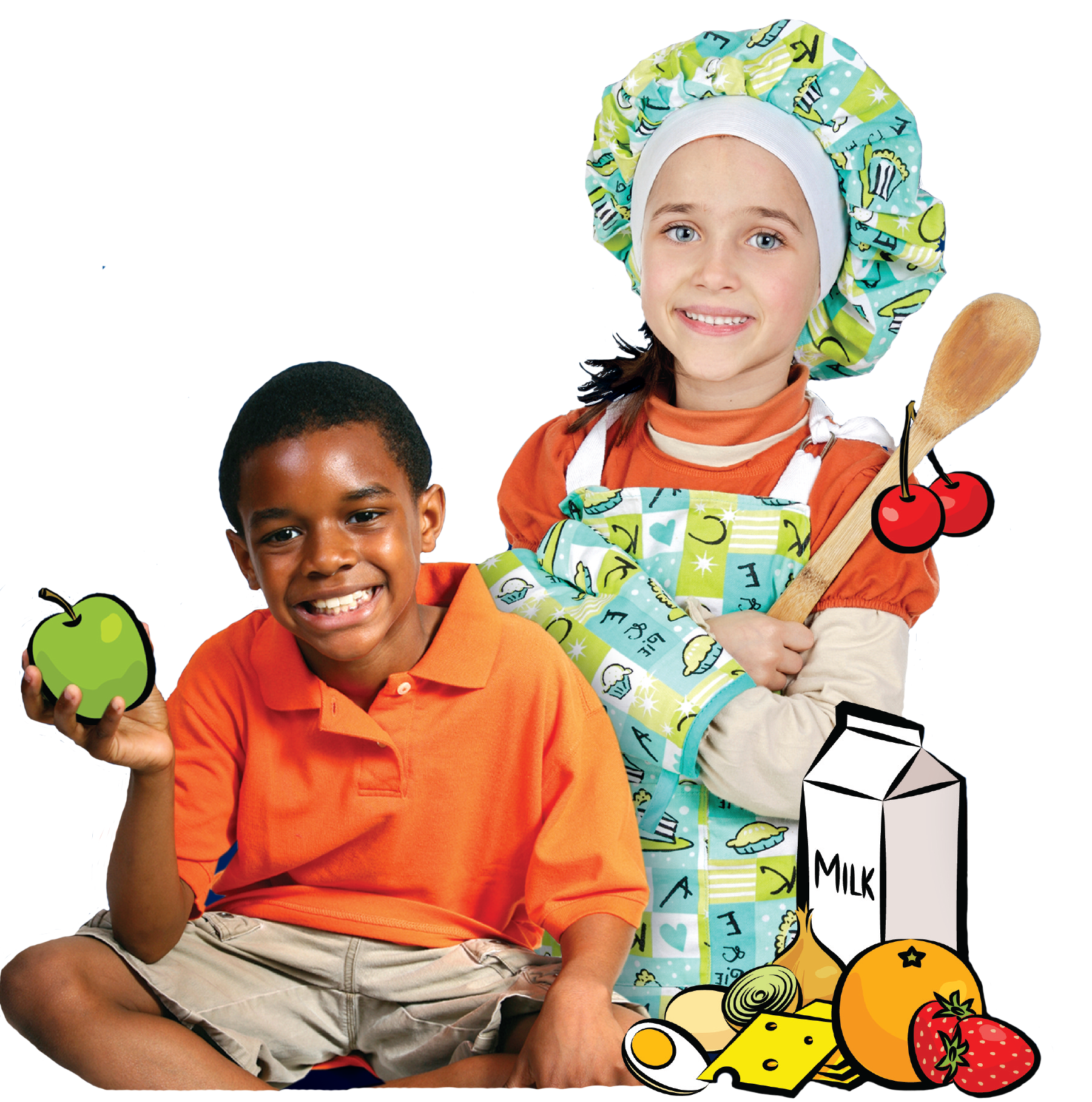
The knowledge and skill development that can be inspired by the FoodMASTER approach is limitless. Proper use of measurement tools, data collection and interpretation, application and generalization, classification and organization, graphing and comparative analysis, understanding chemical changes, observing functions of ingredients and controlling variables, pricing, critical thinking, self-directing learning, and team building are only a few of the potential knowledge and skill development areas for intermediate grade students experiencing FoodMASTER’s scientific inquiry labs.
Additional FoodMASTER lessons can be found to cover health and nutrition topics such as:
- Food Safety
- Vegetables
- Fruits
- Meat, Poultry, and Fish
- Eggs
- Fats and Oils
- Grains
- Measurement
- Meal Management
Background for this Lesson:
Milk, cheese, yogurt and ice cream are all part of the dairy group. Drinking milk helps build strong bones! Kids, ages 2 to 8, need to eat or drink 2 cups from the dairy group a day. Older kids need 3 cups from the dairy group every day. Sadly, most Americans do not drink or eat enough foods from the dairy group. In this chapter, your students will taste test milks, learn how to read food labels and make cheese.
In this lesson, students will:
- locate calories, fat and calcium on food labels;
- communicate how the four milks are different and use food labels to complete a table to draw reasonable conclusions;
- select appropriate measurement tools for measuring temperature and volume;
- practice measurement skills using appropriate units for temperature and volume;
- explain curds and whey to family/friends; and
- make a prediction and complete a bar graph.
Engage
- Introduce the lesson by reading the clues below and ask the students to make a guess for which food item you have described.
- This food should be consumed after you exercise because it has protein for your muscles, carbohydrates to give you energy, and electrolytes to keep you hydrated.
- This food is produced by all mammals, but cattle provide most of it for our food supply.
- This food is the most abundant source of the nutrients necessary for strong and healthy bones.
- This food starts on a farm called a "dairy."
- This food can be processed into other healthy foods such as cheese and yogurt.
- What food is it? Milk!
Explore and Explain
Activity 1: Many Milks
Scientific Inquiry: Comparing Milk
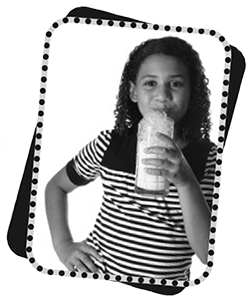
- Read Many Milks and complete the Doodle Bugs.
- Set up four stations, one for each type of milk. Each station should include a sign identifying the type of milk, one small cup per student with one to two ounces of the milk inside and a tray or trash can for discarding cups.
- Students may predict which milk will taste the best and the worse and which milk will be the healthiest.
- Divide the class into four groups. The groups will rotate to each of the four stations, taste testing the milk at each station and completing the Milk Taste Test table.
- Next, students will explore milk food labels. Tell your class that most foods are required to have a food label with Nutrition Facts. Explain that you can compare the nutrition of two different foods or brands by reading the label. Then show the class where to find the serving size, total calories, fat and calcium on a food label. Point out that different units are used for different nutrients. The units include calories, grams and milligrams.
- Give each group one food label to read (either a label directly from one of the milk containers or a copy from this manual). Ask the groups to complete the line on the Milk Nutrition Facts table for their specific milk. Remind them to include units of measurement.
- Use each group’s answers to complete the rest of the Milk Nutrition Facts table as a class.
- Finish up the lesson by instructing students to answer the final questions and holding a class discussion.
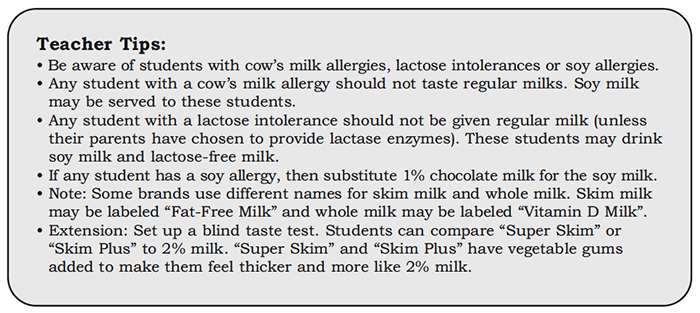
Classroom Discussion
- Which milk do you think tastes the best? The worst?
- Which milk is the healthiest?
- Has anyone tasted skim milk before? Did you like it? Did it have more, less or the same amount of calcium as the other milks?
- Do you think you could switch to a lower fat milk, like skim milk?
- Did you know some people are allergic to cow’s milk and cannot drink it without getting sick? Other people are lactose intolerant and can’t drink cow's milk either. Soy milk is a good option for people who can’t drink cow’s milk. However, some people may be allergic to soy, so soy milk is not an option for everyone. (People with a lactose intolerance can drink Lactose Free milk or take lactase enzymes when they drink regular cow’s milk.)
- Has anyone tasted soy milk before? Did you like it? Did it have more, less or the same amount of calcium as the other milks?
- Do you think you get more nutrients from drinking soda-pop or milk? kool-aid or milk? Tea or milk?
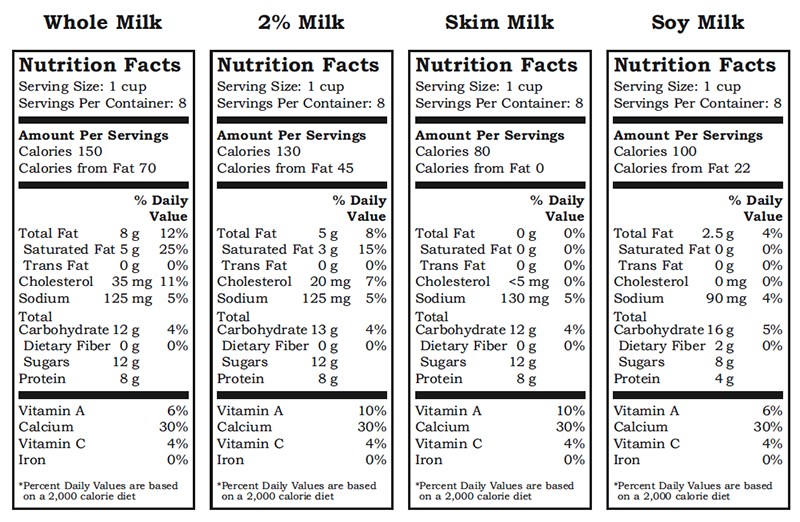
Activity 2: Making Cheese
Scientific Inquiry: Curds and Whey
- Begin heating milk in a large stainless steal pot, over medium-high heat. It will take about 30-40 minutes to slowly heat the milk, so plan accordingly.
- Read Making Cheese and complete the Doodle Bugs.
- Follow the Scientific Inquiry: Curds and Whey instructions. Allow students to check the temperature and measure the vinegar. Be sure all students are given a chance to observe the separation of curds and whey.
- While the curd is cooling, complete While You Wait: Tasty Cheese. Discuss low-fat cheese.
- After the curd has cooled for about 30 minutes, drain the whey. If the curd is cool enough, students may help squeeze the whey from the curd using a cheese cloth. Or students can remove additional whey by pressing the curd down into the strainer with a large spoon.
- Place drained curds in a bowl. Allow students to measure the salt, add the salt and stir the cheese.
- Serve the fresh cheese on small plates with crackers.
- Students will complete the Cheese Facts table. Remind students that this cheese is like cottage cheese. Ask students “What additional steps are used to make hard cheeses like cheddar cheese?” (Pressing the curd into chunks of cheese and aging the cheese).
While You Wait: Tasty Cheese
- Pass out a piece of cheese A and a piece of cheese B to each student. Students may place their cheeses on a plate or napkin. Remind them not to mix up Cheese A and B.
- After students have tasted both cheeses and answered questions one to three, reveal the true low-fat cheese.
- Count the number of students whose prediction was correct and the number of students whose prediction was incorrect. Use this information to complete the Students’ Correct/Incorrect Predictions for Low-fat Cheese graph.
- Discuss how well they liked/disliked the low-fat cheese. Be sure to mention that the low-fat cheese has fewer calories but the same amount of calcium. Ask “Does anyone already eat low-fat cheese at home?” Ask “Do you think you could ask your parents to buy low-fat cheese?”
- Discuss how low-fat cheese and regular cheese are made.
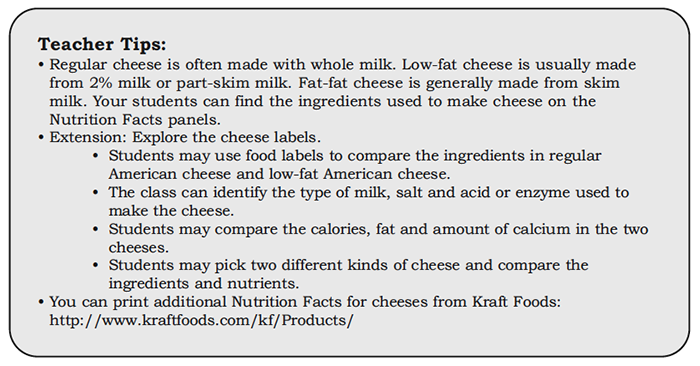
Elaborate
-
Farmer's Market Tour: Arrange a tour of your community's farmers' market in the fall or spring to observe the variety of food items farmers have produced. Assign students to talk with the farmers to learn more about what they do. If a real tour is not possible, have students do a virtual tour online or invite one or more local farmers to talk about their role and the work they do in your community.
-
Visit the Interactive Map Project website and view the Dairy Cattle Inventory map. As a class identify the highest milk producing states and discuss the factors which could contribute to the success of dairy farms such as climate, open space, etc. Identify where your state ranks in dairy cattle production and discuss the factors contributing to the statistic.
-
Visit the Interactive Map Project website and view the maps representing Milk and Cheese Production in the United States. Identify the states that produce the most milk and cheese, then find where your state ranks for milk and cheese production. Ask students if they can find a correlation between the information found in the two maps. (The top producing cheese states also rank in the top for milk production.)
-
Bacteria for Breakfast: Complete the math enrichment activity included with this lesson. Students will learn about the beneficial bacteria found in yogurt and calculate serving sizes.
Evaluate
After conducting these activities, review and summarize the following key concepts:
- Milk is produced on farms by dairy cattle.
- Milk and dairy products can be purchased in non-fat, reduced-fat, or without fat reduction.
- The nutrition fact label can help you determine the nutrients contained in a particular food.
Acknowledgements
- Created by: FoodMASTER (Food, Math, and Science Teaching Enhancement Resource)
- Sponsored by: SEPA (Science Education Partnership Award)
- Partnered with: Ohio University and East Carolina University
- Graphics provided by FoodMASTER
Recommended Companion Resources
- A Big Cheese for the White House: The True Tale of a Tremendous Cheddar
- Biotech Cheese Kit
- Casper Jaggi: Master Swiss Cheese Maker
- Clarabelle
- Dairy Reader
- Dairy in the Mountain West: Our Family of Farmers
- Discover Dairy
- Eat Happy Project Video Series
- Extra Cheese, Please!
- Food Group Puzzle
- Ice Cream: The Full Scoop
- It's Milking Time
- Labels Unwrapped
- Let's Make Butter
- Look Inside Food
- Make Mine Milk
- Mozzarella Cheese Kit
- NMSU Field Trip: Milk
- Say Cheese! A Kid's Guide to Cheese Making
- The Journey of Milk
- The Milk Makers
- The Science of Cooking